July 12 , 2010 – 07:58 am EDT
Congratulations to Spain on winning the World Cup! They did well, there were some moments of brilliance (and 118 minutes of boredom) but the fireworks display was amazing. As for the market, warning signs of an oversold bounce were there and over the last few days the majority of the losses from the previous week were recovered. What does surprise me however, is that now with just a little more follow through, volume flows will turn positive and we will return to the bull market. The question is; will there be any follow through?
****Get value from this newsletter? If you do then please remember to invite others to subscribe, we grow by word of mouth (that means we need YOUR help). Thanks in advance!
.
ETF % Change Comparison
.

It is rather impressive to see that SMH is now up 0.81% over the last four weeks and down under 10% from its peak 85 days ago. At turning points the Semiconductors tend to lead so this gives further backing to the bullish argument.
.
What the % Comparison Table Tells Us:
By comparing the performance of the economically sensitive (SMH, QQQQ, IWM, IYT) and the comparatively stable ETFs (SPY and DIA) we can get an indication of the true market direction. The more sensitive areas of the market tend to be the first to initiate a trend change. For example if DIA and SPY sell off heavily while SMH and IWM (Russell 2000 small cap ETF) sell of mildly or continue moving to new highs then this would be very positive and vice versa.
The ‘Average Rank %’ is calculated by subtracting the % change for each ETF from the maximum % change and dividing it by the range for each period. 1-((MAX(% change all ETFs)-ETFs % Change)/(MAX(% change all ETFs)-MIN(% change all ETFs))) The readings for each period are then averaged. This reading is provided because if one ETF was significantly under/out performing the others then a plain high or low rank would not accurately reflect this.
.
![]()
.
A Look at the Charts
.
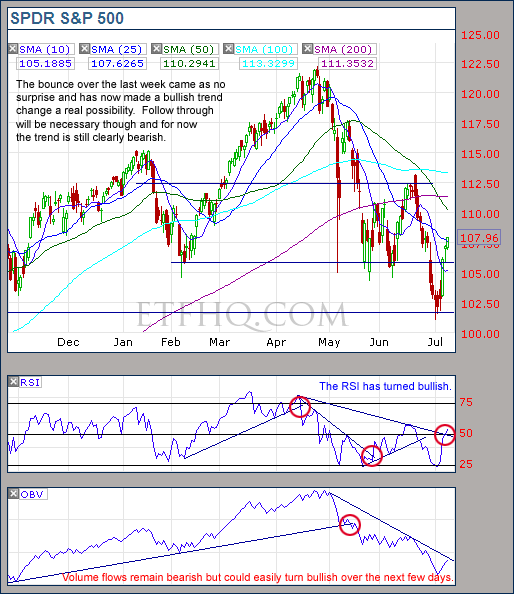
SPY is on the verge of a trend change but it will need to be confirmed by QQQQ and IWM.
.
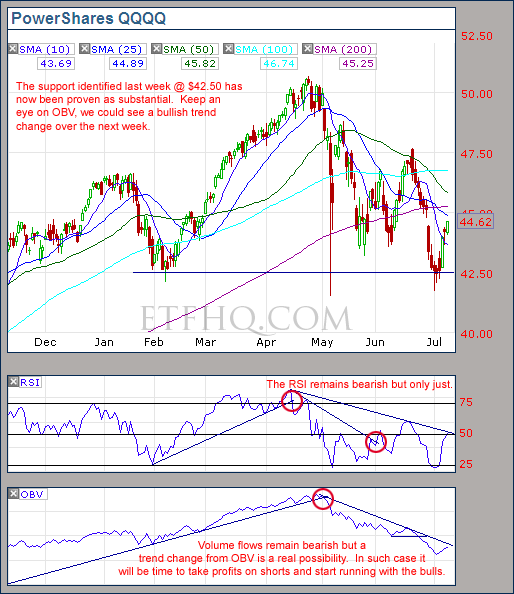
With volume flows suddenly within range of turning bullish and solid support underfoot the coming week will be interesting.
.
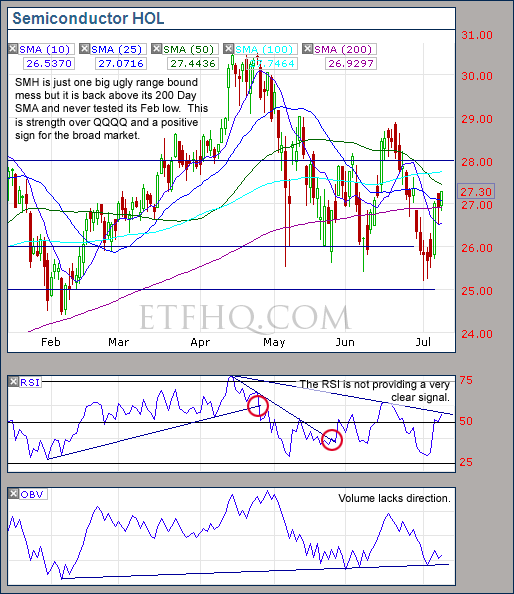
SMH may not have a clear direction but it is positive to see it outperforming QQQQ and SPY.
.
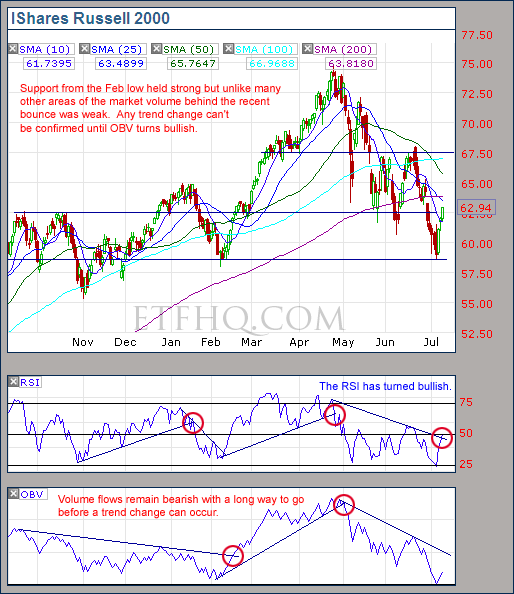
The small caps need to see much more positive volume before a trend change can be confirmed.
.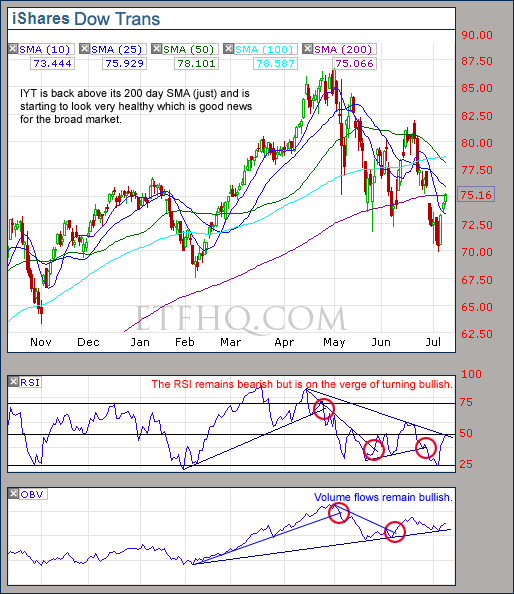
We have been saying for a while now that it is strange for the Transports to have such strong volume flows if the market really is in a long term bear market. This makes a bullish trend change by the broad market all the more of a possibility.
.
![]()
.
OM3 Weekly Indicator
.

‘Sell Signals’ indicate that the trend is still down but the ‘Bull Alerts’ indicate that the weekly cycle has turned up.
.
How to read the OM3 indicator
The OM3 indicator as with most of our models primarily reads price action and volume. The strong/weak buy/sell signals are self-explanatory. ‘No Signal’ means that the component readings are in conflict and cancel each other out.
The alerts let you know if the cycle is speeding up or slowing down, so when you get at ‘Strong Buy, Bear Alert’ for instance it simply means that the criteria for a strong buy is in place but this weeks cycle reading is weaker (or more bearish) than last weeks reading (the same is true in reverse).
The number of weeks that a signal has been repeated is displayed. Historically a ‘Strong Buy’ signal has lasted for an average of 6 weeks and a maximum of 42 weeks, while a ‘Strong Sell’ has lasted for an average of 4 weeks and a maximum of 16.
This is an indicator not a mechanical trading model. It is useful to assist in analyzing the market but for the best results should be combined with commonsense and support/resistance levels etc.
.
![]()
.
TransDow & NasDow
.

For the NasDow there continues to be no clearly dominant index while for the TransDow the Dow remains dominant. Historically the market has been very unproductive under these conditions and has seen the majority of it’s major declines.
.
What the TransDow Readings tell us:
The TransDow measures dominance between the DJ Transportation Index (DJTI) and the Dow Jones Industrial Average (DJIA). In a strong market the more economically sensitive Transportation Index should be dominant over the DJIA.
Historically the DJTI has been dominant over the Dow 45% of the time. The annualized rate of return from the DJTI during this period was 18.47% with the biggest loss for one trade sitting at -13.27%. The annualized return from the DJIA during the periods it was dominant over the DJTI was just 4.06% and the biggest loss for one trade was -16.13%. A 4% stop-loss is applied to all trades adjusting positions only at the end of the week.
What the NasDow Readings tell us:
The NasDow measures dominance between the NASDAQ and the DJIA. Using the same theory behind the Trans Dow; in a strong market the more economically sensitive NASDAQ should be dominant over the DJIA.
Historically the NASDAQ has been dominant over the DJIA 44% of the time. Taking only the trades when the NASDAQ is above its 40 week moving average the annualized rate of return was 25.47% with the biggest loss for one trade sitting at –8.59%. The annualized rate on the DJIA during the periods it was dominant over the NASDAQ is just 8.88% and the biggest loss for one trade was –12.28%. A 8% stop-loss is applied to all trades adjusting positions only at the end of the week.
.
![]()
.
LTMF 80 & Liquid Q
.

Both LTMF 80 and Liquid Q remain in cash.
.
Historical Stats:
.

.
How The LTMF 80 Works
LTMF stands for Long Term Market Forecaster. It reads volume flows relative to price action and looks for out performance of volume measured on a percentage basis over the prior 12 months. During a sustained rally the readings will reach high levels (near 100%) making it imposable for the volume reading to always outperform price so any reading above 80% will maintain the buy signal. This system has outperformed the market over the last 10 years but performance has been damaged by some nasty losses. It only produces buy signals and only for QQQQ.
How Liquid Q Works
Liquid Q completely ignores price action and instead measures the relative flow of money between a selection of economically sensitive and comparatively stable ares of the market. It looks for times when the smart money is confident and and can be seen by through volume investing heavily is more risky areas due to an expectation of expansion. This system has outperformed the market over the last 10 years and remained in cash through most of the major declines. It only produces buy signals and only for QQQQ. We will provide more performance details on the web site for these systems soon.
.
![]()
.
Summary
.
The ‘Over Sold’ bounce that we were expecting may well turn out to be the start of a bullish trend change. If volume flows on IYT remain bullish and we see a trend change from OBV on QQQQ and IWM then it will be time to establish long positions again. Until then we remain in a bear market.
.
Any disputes, questions, queries, comments or theories are most welcome in the comments section below.
.
Derry
And the Team @ ETF HQ
“Equipping you to win on Wall St so that you can reach your financial goals.”
.
P.S Like ETFHQ on Facebook – HERE
.
![]()
.
Quote of the Day:
“You do things when the opportunities come along. I’ve had periods in my life when I’ve had a bundle of ideas come along, and I’ve had long dry spells. If I get an idea next week, I’ll do something. If not, I won’t do a damn thing… You only have to do very few things right in your life so long as you don’t do too many things wrong.” – Warren Buffett